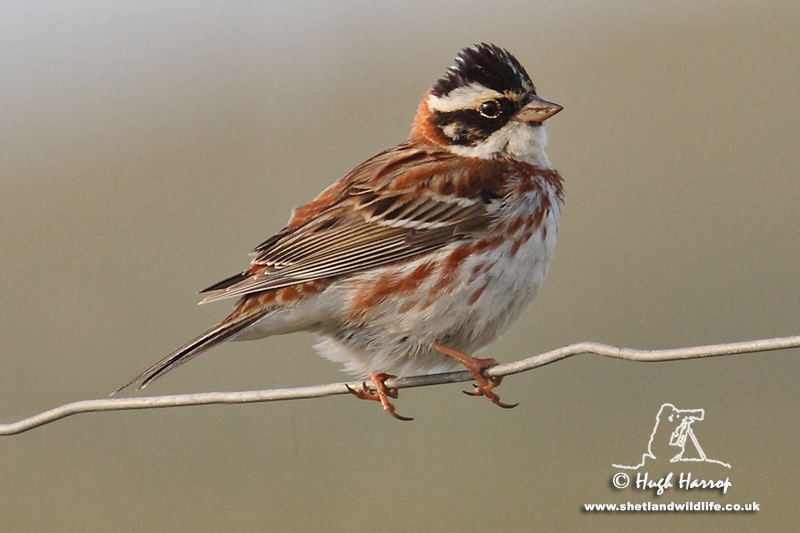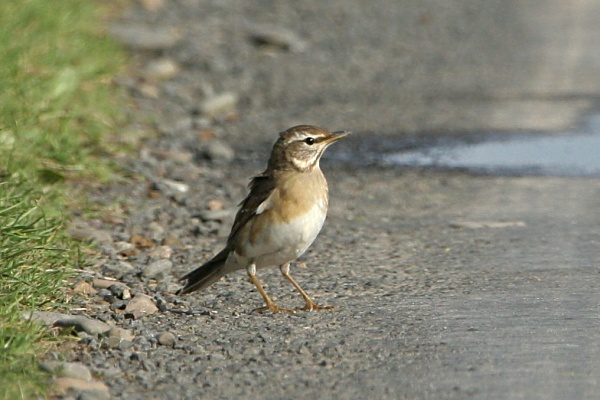"Last night, we all saw a pair of Eye-browed Thrushes by merely looking out the dining room window."
Attu Island is known as the premier migration spot in North America for seeing stray Asian vagrants. The year, 2000 is the last year birders are able to visit the island.
The following extracts are from Sandy Komito's latest book "I Came, I Saw, I Counted" chronicling his exhausting adventures during his North American Big Year quest in 1998. Sandy went on to shatter records in this year tallying a grand total of 745 species (more details about his book at the bottom of the next page).
It's May, so it's time to start thinking about Alaska. After birding the Anchorage area for the past two days, I'm physically and psychologically ready for the next twenty-nine days which will be spent on Attu Island. The Attu Island portion of the trip can make or break the Big Year. If Attu delivers, as hoped for, this could turn out to be a very good year; if not, I'll pack it in and go back to playing golf for the rest of the summer.
In man's recent past, there have been names that have struck fear into the heart, just at their mere mention. Devil's Island and Alcatraz are to name but two. Some say, Attu Island should be added to the top of this fearsome pair. Attu, the most western of the Aleutian Islands, lies nearly fifteen hundred miles due west of Anchorage. It's so far west, they had to bend the International Date Line to accommodate it. The longitude is just about even with New Zealand!

The Aleutian Islands separate the northern Pacific from the Bering Sea, thus creating two separate bodies of water. Attu is known from earlier times, as the place where the Russians forced the Aleut natives into virtual slavery for their fur trading business. The island still has names like Murder Point and Massacre Bay, thus memorializing what happened at these places long ago. During World War II, the US suffered some of its worst losses of the war, in an effort to recapture this strategically located island.
Today, one can still see foxholes, the remains of military structures and abandoned equipment in various areas. Most of the island is intraversable, with steep mountains rising above three thousand feet and snow-covered most of the year. The ground is covered with a soft layer of tundra grass into which one sinks with each step. The conditions are less than ideal for comfortable living or travel.
Many mornings, we have no water for washing because our water lines freeze during the night. We are housed in a one story, pre-World War II building that becomes a reservoir during and after heavy rains holding water in. Sleeping areas are small and cramped, smaller than those on Devil's Island, where prisoners rioted to protest the conditions. What is Attu really like? It has cold, winter-like conditions, strong winds, nearly daily precipitation, cramped housing, upper respiratory infections that spread like wildfire through the compound, aching muscles as we pedal from place to place over soft sand, rocks, mud, potholes filled with water and the ever present head winds. So why would anyone voluntarily come here and pay thousands of dollars for the privilege? In a sentence, it's for the birds! Birds with exotic names like Siberian Rubythroat, Far Eastern Curlew and Mongolian Plover. Our thoughts are filled with hopes and dreams that we too can see them and add another exciting name to our lists.
After yesterday' strong westerly winds, it is a great relief to find moderate winds today, although still from the west. At nine in the morning, as participants gather outside Lower Base to learn where the various leaders are going, the Attu Casino is now officially open. Jerry Rosenband announces where different leaders are going thus making us the birding handicappers. We now place our bets on which leader will find the birds we need. You bet your time and energy on which "horse" you'll ride. Unlike racing, you can change your bet at any time and can bet on more than one "horse," It's sort of a win/win situation with the payoff being new and better birds for the list. Ah! the all important list!
I start by joining Craig Robert's group at Barbara Point where we see a Peregrine Falcon power-dive after a Tufted Puffin. The puffin, in an effort to escape, hits the water like a rock. As we watch small flocks of Ancient Murrelets and Common Murres bobbing in the calm waters of Casco Cove, our attentions are turned to a Rock Sandpiper and a Ruddy Turnstone, poised on a water-smoothed rock. The peacefulness of the area is soon shattered by a call reporting a Common Sandpiper at Smew Pond, some three miles away.
Everyone else's bicycle seems faster than mine, as I drag along the muddy and sometimes rocky path, made a bit smoother by the hundreds of bicycles that have passed before me. Just before reaching the sandpiper site, I see a dozen people racing away from the sandpiper and learn an Eye-browed Thrush has been seen at Murder Point, a distance of six more miles back from where I came. I manage to get two different views of the sandpiper through telescopes, before leaving and pedalling towards Murder Point. Along the way, I learn they also have three Olive-backed Pipits in the same area.
After parking my bicycle, I begin to trudge up the very steep hill heading towards South Beach and Murder Point. Off to my right, seven or eight people are standing in a semi-circle looking towards where the pipit had been. As they begin to walk towards higher ground, Mike Toochin calls out that he has the bird in his scope. Being the first to reach him, and after studying the pipit rather carefully, I ask him for directions to the site of the Eye-browed Thrush. I do my own version of an old man sprinting across the ever-yielding tundra.

On the north side of a lake between South Beach and Murder Point, I see Dick and Gloria Wachtler, Joe Swertinski and my roommate, Eric Carpenter, all gazing south, looking for birds. Gloria is first to spot another Olive-backed Pipit as it wriggles its way through the tundra grass. I look through Gloria's scope and then return to my vigil. Eric is first to call out "Eye-browed Thrush." "Where?" we all shout in unison. "Right above the big rock." We all then focus on the prized bird. Joe focusses his Kowa telescope on the thrush and after a few moments asks me "Would you like to see it through the scope?" With that, I view the thrush for nearly half a minute. As we try to give others directions as to the bird's whereabouts, two Rustic Buntings fly overhead giving a "chup, chup" call note. Soon, a female Rustic Bunting lands on the ground less than forty feet from where we are standing.
At this point, I'm delighted to have seen all these rare birds but I'm starting to feel a bit apprehensive about being so far away from my bicycle (just in case another rarity shows up somewhere). I, therefore, begin a trek back to where the bike is parked. By lunchtime, a call comes over our radios advising they have discovered a Mongolian Plover near Casco Cove. I'm delighted to be in position to chase it with minimal effort. Others behind me, are doing wind sprints to try and get to their bicycles.
Being among the first to arrive at the east end of the cove, I learn that the plover flew off, shortly after the initial report was made. After more people arrive, a sweep is organized across the rocks and kelp-covered beach in an effort to sight or flush the plover. Instead, we find eight Long-toed Stints and three Temminck's Stints. We check all along the beach, failing to relocate the plover but do manage to find an adult Slaty-backed Gull. We continue towards Barbara Point, where a male Rustic Bunting makes a brief appearance before dropping down into the tall, protective grasses. Wind- driven sleet, which lasts through most of the afternoon, fails to dampen the enthusiasm of any of the participants and we continue searching for whatever birds we can find.